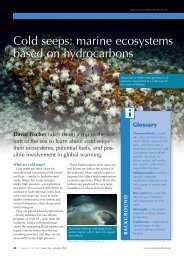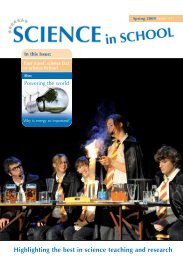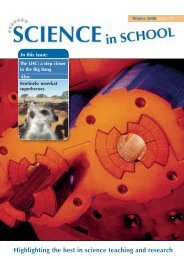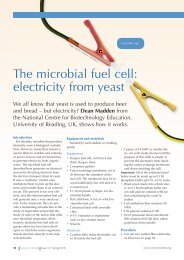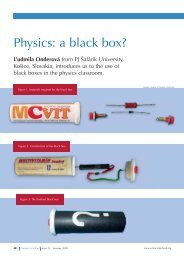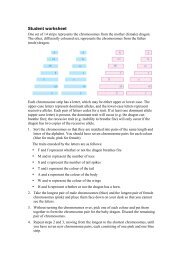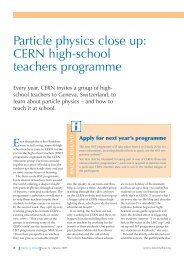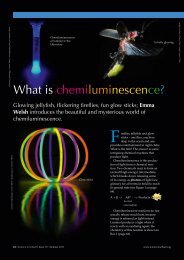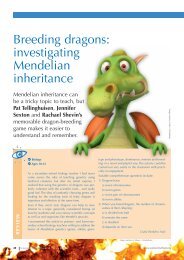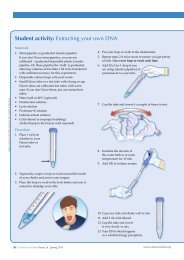Download Issue 14 as PDF [5.4 MB] - Science in School
Download Issue 14 as PDF [5.4 MB] - Science in School
Download Issue 14 as PDF [5.4 MB] - Science in School
You also want an ePaper? Increase the reach of your titles
YUMPU automatically turns print PDFs into web optimized ePapers that Google loves.
Gett<strong>in</strong>g ahead <strong>in</strong> evolution<br />
Image courtesy of NaluPhoto / iStockphoto<br />
Lucy Patterson talks to Èlia Benito Gutierrez, from the European<br />
Molecular Biology Laboratory <strong>in</strong> Heidelberg, Germany, about<br />
how Èlia’s favourite animal, amphioxus, could be the key to<br />
understand<strong>in</strong>g the evolution of vertebrates.<br />
Èlia Benito<br />
Gutierrez<br />
In the lab,<br />
Èlia uses high-powered<br />
microscopes<br />
to take a close look<br />
at the develop<strong>in</strong>g<br />
amphioxous<br />
bra<strong>in</strong><br />
In co<strong>as</strong>tal seabeds around the<br />
world, buried up to the gills, the<br />
worm-like amphioxus filters plankton<br />
from the waves. This h<strong>as</strong> been go<strong>in</strong>g<br />
on for a very long time. Day <strong>in</strong> and<br />
day out, for more than 520 million<br />
years, amphioxus – or someth<strong>in</strong>g<br />
very like it – h<strong>as</strong> filter-fed <strong>as</strong> the<br />
world changed around it. Fish<br />
heaved themselves onto land,<br />
d<strong>in</strong>osaurs rumbled across the pla<strong>in</strong>s,<br />
early man struck fl<strong>in</strong>ts together to<br />
make fire, and all the while,<br />
amphioxus sat there. If you have the<br />
chance to go snorkell<strong>in</strong>g, look out for<br />
them. They might not sound very<br />
dynamic, but these creatures have f<strong>as</strong>c<strong>in</strong>ated<br />
natural historians and scientists<br />
s<strong>in</strong>ce the mid-19th century,<br />
<strong>in</strong>clud<strong>in</strong>g Èlia Benito Gutierrez.<br />
Her <strong>in</strong>terest <strong>in</strong> amphioxus w<strong>as</strong><br />
sparked <strong>in</strong> her first-year zoology<br />
course at the Universitat de<br />
Barcelona w1 , Spa<strong>in</strong>. “Amphioxus w<strong>as</strong><br />
this strange worm-like animal mentioned<br />
at the end of the list of <strong>in</strong>vertebrates,<br />
before the vertebrates,” she<br />
remembers. S<strong>in</strong>ce Charles Darw<strong>in</strong>’s<br />
great revelation 150 years ago, many<br />
have considered amphioxus to be the<br />
key to understand<strong>in</strong>g the orig<strong>in</strong> of the<br />
vertebrates – the group of backboned<br />
animals <strong>in</strong>clud<strong>in</strong>g fish, amphibians,<br />
reptiles, birds and mammals, among<br />
them, of course, us. Èlia’s own niggl<strong>in</strong>g<br />
curiosity brought her, after a<br />
PhD <strong>in</strong> Barcelona and a research position<br />
<strong>in</strong> London, Uk to the European<br />
Molecular Biology Laboratory<br />
(E<strong>MB</strong>L) w2 <strong>in</strong> Heidelberg, Germany<br />
and a pioneer<strong>in</strong>g new amphioxus<br />
project.<br />
Èlia’s project falls under the still<br />
rather new science of ‘evo-devo’ – the<br />
comb<strong>in</strong>ed study of evolution and<br />
Image<br />
courtesy<br />
of E<strong>MB</strong>L<br />
Photolab<br />
development. Scientists are <strong>in</strong>cre<strong>as</strong><strong>in</strong>gly<br />
realis<strong>in</strong>g that the <strong>in</strong>tricacies of<br />
development – how a s<strong>in</strong>gle fertilised<br />
egg gives rise to the <strong>in</strong>credible diversity<br />
of cells and tissues <strong>in</strong> an adult –<br />
have had a major impact on the<br />
course of evolution.<br />
Rather than re-<strong>in</strong>vent<strong>in</strong>g the wheel<br />
every time, new species arise through<br />
tweaks and adjustments to pre-exist-<br />
16 <strong>Science</strong> <strong>in</strong> <strong>School</strong> <strong>Issue</strong> <strong>14</strong> : Spr<strong>in</strong>g 2010<br />
www.science<strong>in</strong>school.org


![Download Issue 14 as PDF [5.4 MB] - Science in School](https://img.yumpu.com/26126440/18/500x640/download-issue-14-as-pdf-54-mb-science-in-school.jpg)


